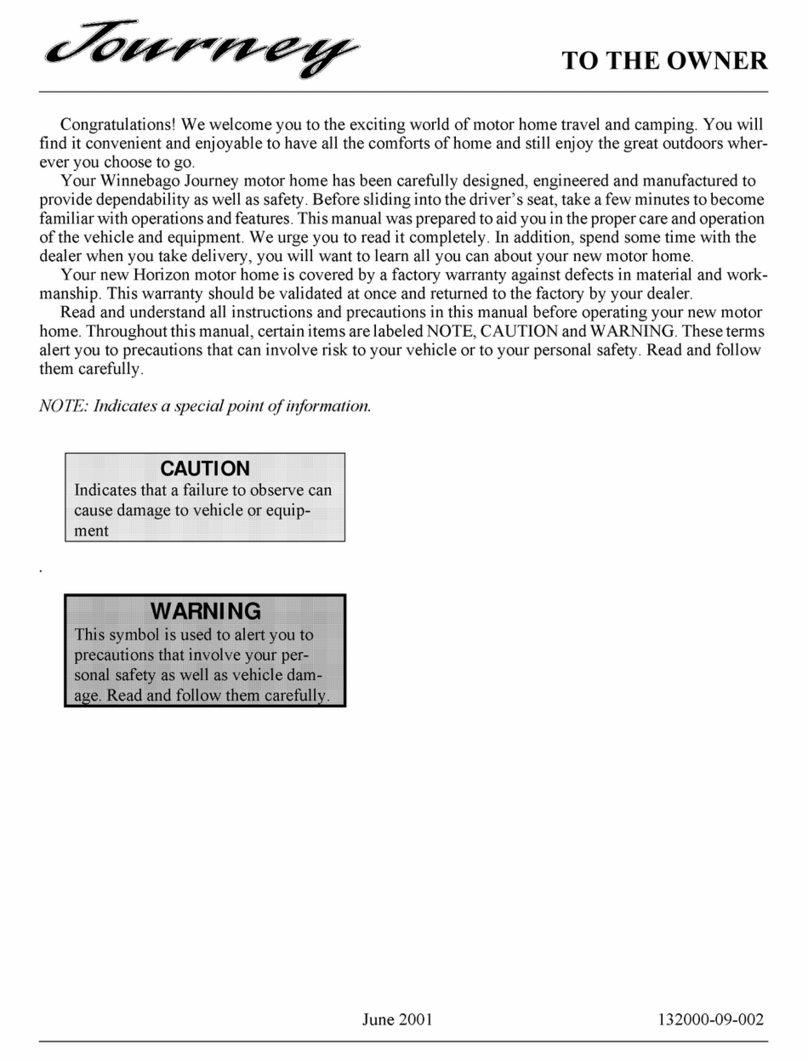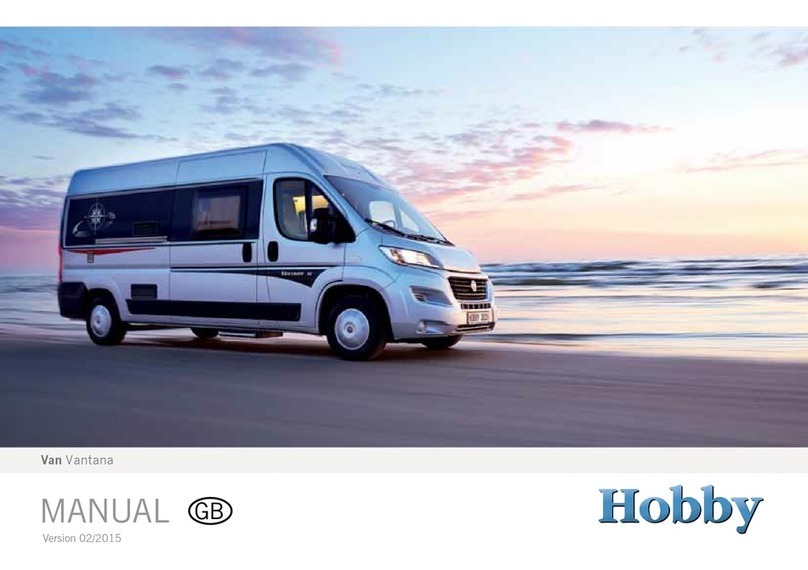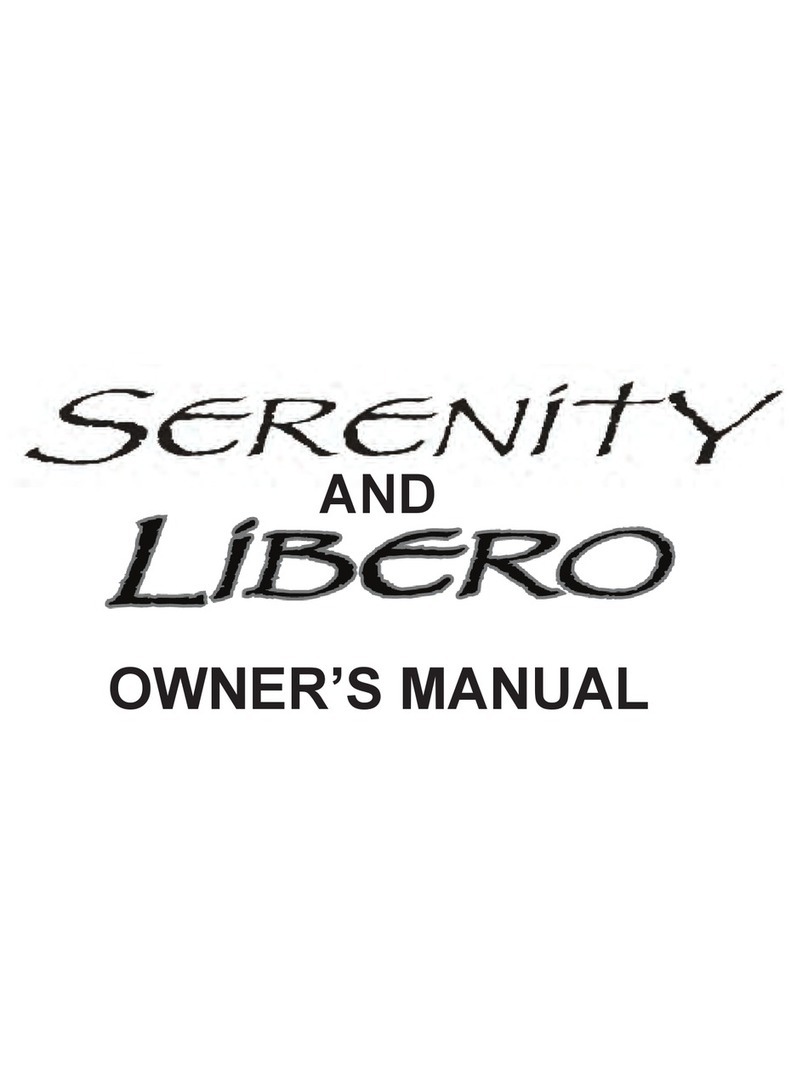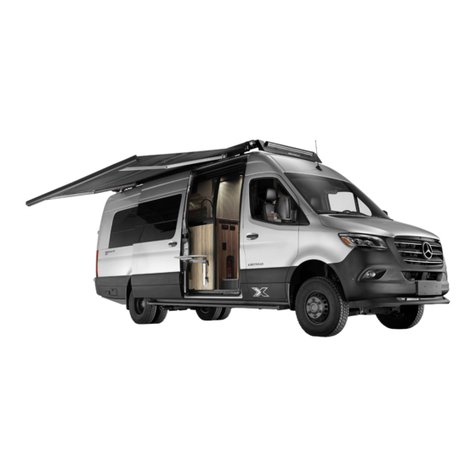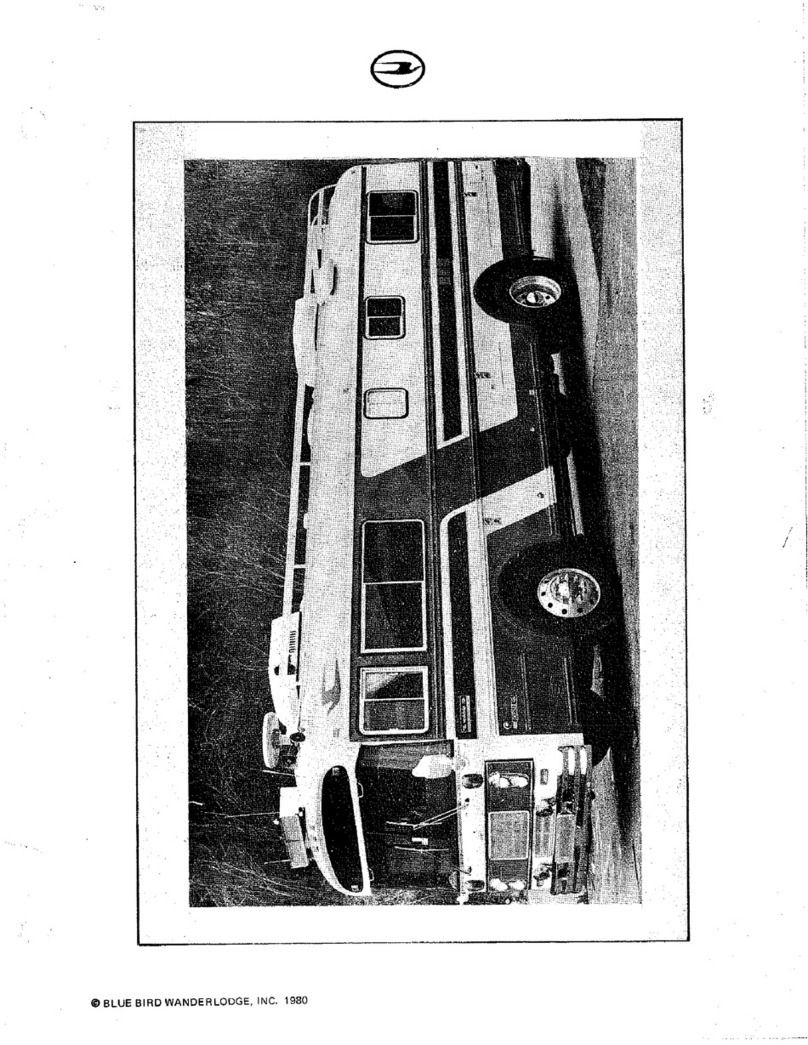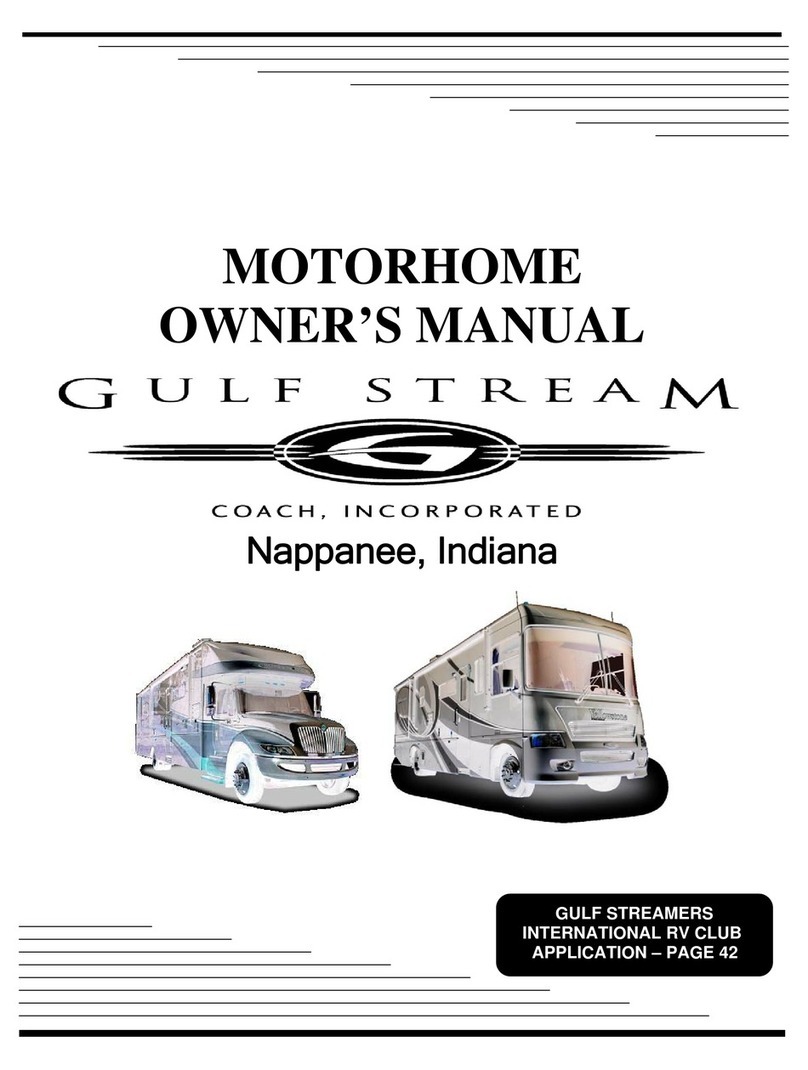Chinook Destiny 2400 User manual


I SERVICE/WARRANTY
Service
is
important to you,
and
it
is equally important to
us.
When
you
buy a Chinook,
you
can
expect years of carefree service with regular but minimal maintenance. Our reputation has been
built
on
that premise.
DOUBLE SERVICE BACKUP
Your Chinook dealer's service department will promptly handle any operational difficulty
you
may
have with your motorhome. If such a problem
is
not resolved to your complete satisfaction,
please take these steps:
1.
Discuss the problem with the general manager or owner of your dealership. Give him the
opportunity to work with his service crew
in
solving
it.
2.
If the difficulty cannot
be
resolved to your satisfaction by your local dealer, contact the
service manager at the Chinook factory for assistance
by
calling:
1-800-552-8886
This double service backup
is
your best assurance that
you
have made the right decision
in
choosing a Chinook.
YOUR DEALER'S RESPONSIBILITIES
Your Chinook dealer has thoroughly inspected your motorhome, resetting the lighting, plumbing,
water and heating systems for any malfunctions that may have occurred during shipment from the
factory.
All
appliances are checked by the dealer at the time of purchase.
He
is
obligated to
explain and demonstrate the operation of your equipment
and
accessories, answer questions and
make minor adjustments. For further instructions
on
operation, maintenance and warranties,
please refer to the individual manuals or instruction sheets provided
in
your owner's packet.
If
you
should require service and replacement of defective equipment, make your request directly
to the manufacturer of the appliance or accessory involved.
In
contacting any manufacturer,
dealer or Chinook factory for service or information,
be
sure to include all the following:
1.
Date of purchase along with stock or vehicle identification number.
2.
Serial and model number
and
a complete description of the product.
3.
Detailed explanation of the difficulty
you
are having.
Replacement parts should
be
purchased through the manufacturer or supplier or through your
local dealer or supply store. If
you
have difficulty obtaining parts or service, contact the Chinook
factory for assistance.
1
I

SERVICE/WARRANTY
REGISTER YOUR WARRANTY TODAYI
As
the original owner your first responsibility
at
the time of delivery is to register your warranty,
so
mail
in
your completed warranty registration card today, Only by filling out
and
submitting your
registration card
can
you
be
assured of the guarantees it provides. This card
is
for your
protection
as
a
consumer;
use
It
now!
Remember,
warranties
do
not
cover
normal
maintenance
service
or
adjustments
which
may
become necessary through normal extended use. That
is
why,
after you have met your first
obligation by submitting your warranty card, you must
be
prepared for
an
on-going responsibility:
preventive maintenance.
You
have just bought the finest motorhome
in
the world,
and
we
want
you
to enjoy every mile of it.
All
you
have to do
is
rely
on
the tips
and
recommendations offered
on
the following pages.
COACH SHELL WARRANTY:
Our unique fiberglass, one piece molded shell
is
covered by a lifetime warranty to the
original
owner.
Loss
of
time,
inconvenience,
loss
of
use
of
Motorhome,
towing
Charges,
rental
cars
or
other
consequential
damages
are
not
covered
by
this
warranty.
WHAT
IS
COVERED:
FACTORY DEFECTS ONLY -Factory defects will
be
determined by the Chinook
Engineering Department or
an
authorized representative of Chinook.
WHAT
IS
NOT COVERED:
1.
Gel
coat fractures
2.
Gel
coal discoloralion
3.
Rock chips
4.
Collision damage
5.
Vandalism
6.
Natural disaster damage
7.
Fastener point damage from non-factory installed components
2
I

SERVICE/WARRANTY
CHINOOK LIMITED WARRANTY
CHINOOK
WARRANTY
COVERS:
Your new Chinook Motorhome
is
covered by a manufacturer warranty of three years or 36,000
miles, whichever comes first. Under this warranty, Chinook will repair or replace any defects
resulting from poor workmanship
on
the motorhome manufactured at our production facility
in
Yakima, Washington. This three year/36,000 mile warranty applies only to the first owner and
is,
therefore, not transferable.
Chinook does not manufacture the chassis, chassis equipment, nor the trade equipment installed
in
the Motorhome, such as the refrigerator, range, heater, air conditioner, power plant, television,
video cassette players,
etc.
The chassis and such trade equipment are warranted separately
by
the manufacturers of each product. The Chinook warranty applies only to the labor
and
materials
provided by Chinook
in
the installation of such items.
WHAT IS
NOT
COVERED
BY
THE
WARRANTY:
t.
Malfunctions resulting from misuse, negligence, alteration, accident, lack of required
maintenance, overloading beyond the applicable weight rating, use of circuits,
VOltages
or
frequencies other than those indicated
on
the appliance name plate.
2.
Loss
of
time, inconvenience,
loss
of
use
of
the Motorhome, towing charges, rental cars or
consequential damages.
3.
Any Motorhome
on
which the odometer mileage has been altered
and
the actual mileage
cannot
be
readily determined.
4.
Any Motorhome registered
and
normally operated outside of the United States or Canada.
The warranty for these Motorhomes shall
be
that authorized for the country in which the
vehicle
is
registered
and
normally operated.
5.
The warranty
is
valid only to the original owner. It does not cover subsequent owners of the
Motorhome.
3
I

I SERVICE/WARRANTY
CHINOOK'S OBLIGATIONS:
1.
Repairs qualifying under this warranty will be performed by any authorized Chinook dealer or
the Chinook Service Department upon a pre-arranged appointment.
2.
During the first ninety
(90)
days of the warranty period, any authorized Chinook dealer will
make
the following service adjustments, if needed, at no charge to the owner:
1.
Fix any electrical shorts
2.
Check the L.P.G. system
3.
Tighten bolts, fasteners, and fittings
4.
Fix any and all water leaks (one year)
4
I

FLOOR PLANS &FEATURES
GENERAL
Your Chinook motorhome
is
a compact, yet versatile, recreational vehicle loaded with features
designed for your comfort and convenience, To help you
in
locating and identifying these
features, refer to the floor plans shown
in
Figures
10.1
through 10.3
in
Section 10. Note that,
while only the dinette option
is
shown, all other components are identical among the three floor
plan options (dinette, club
and
twin-bed). Also, many of the features shown are options
(identified with
an
asterix)
and
mayor
may
not
be
in
your motorhome.
SYSTEMS MONITOR PANEL
At the press of a button
you
can determine the fluid levels
in
the fresh water tank, waste water
holding tanks,
and
LP
gas tank from the systems monitor panel located
on
the range hood (refer
to the chapter
on
the waste water system for false tank readings). This panel also includes the
monitoring of the charge level of the coach batteries, the water
pump,
hood light and hood
fan
switches.
(See
Photo 2.1)
APPLIANCES
Your motorhome
is
loaded with top-of-the-line, name brand appliances. Operating instructions
and specifications for these appliances
can
be
found
in
your owner's packet. Appliance
specifications are also listed
on
a label located
on
the inside of the closet door.
5
I

I FLOOR PLANS &FEATURES
COACH BATTERY SYSTEM
All
models of the Chinook motorhome come with a state-of-the-art battery system that includes a
Low Voltage Disconnect (LVD) and a "Smart" solenoid, With the
LVD,
accidental drainage of
your coach batteries will be minimized, if not eliminated entirely, With the "Smart" solenoid, you
will be able to charge your coach batteries
as
well as your vehicle battery, while eliminating the
possibility of accidentally draining your vehicle battery through the coach batteries or vice-versa,
Refer to chapter 4 on the electrical system for more information,
CLOCK
The clock
in
your motorhome is operated off a battery, which should last approximately one year,
To
reset the clock, first remove the clock from the cabinet by twisting it counter-clock-wise, and
then turn adjustment knob
on
the back, (See Photo 2.2)
I

FLOOR PLANS &FEATURES
SLEEPING ACCOMMODATIONS
Sleeping accommodations vary from model type
and
floor plan and may even be unique to your
motorhome, if you ordered it with special options. The sofa-bed, offered
in
the Club
and
Dinette
floor plans, is folded out to the sleeping position as shown below.
On
Dinette floor plans, the
sofa-bed forms a larger bed with the dinette seats when they are configured with the dinette table
lowered as shown below.
STEP
T
ROT~TE
LEG
UP
AND
UNDER
TABLE
TOP.
STEP
2.
TILT TAgLE TOP
DOWN
TO
DISENGAGE
rRO~
UPPER
W.o.Ll
SUPPORT.
\
SOFA-BED
TO
CON~ERT
SOFA-BED
TO
SLEEPING
POSITION
PULL
UP
ANO
OUT
ON
FRONT
BOTTO~
EDGE
OF
sor
..
AS
INDICATED
BY
ARROWS.
DINETTE-BED
7
STEP
3.
LOWER
TABLE
TOP
TO
SUPPORT
CLEATS
ON
SEATS
BY
ROTATING
BRASS
HINGE
ASSEt.t8LY
ABOUT
LOWER
WUL
SUPPORT.
,uPPO.T
CLEAT
STEP
4.
PLACE
SEAT
BACK
CUSHIONS
FROt.l
BOIK
SEATS
ONTO
THE
TABLE
TOP
TO
fORI.! A
LEVEL
SLEEPING SURFACE.
lDV/,.
WALL
SUPPORT
I

I FLOOR PLANS & FEATURES
Note: The sofa bed is electrically powered
and
is
activated with the switch located
on
the forward
side of the galley cabinet. The unit
is
fused off of battery breakers located under the vehicle
on
the passenger side just to the rear of the running board
and
inside of a plastic access cover.
(See
Photo 2.3 and Photo 2.4)
Photo 2.3
Photo 2.4
8
I

I VEHICLE OPERATION
PLANNING YOUR TRIP, BEING PREPARED
Planning your trip
is
an
exciting time -
and
a time
when
you
are likely to forget something
important
in
your last minute rush to get ready.
Being properly prepared is the key to getting the most enjoyment from your motorhome, and that's
why
we
are offering the following suggestions as a guide. Review them before starting out, refer
to
them when you are
on
the
road,
and
then note the items
you
have forgotten
so
your next trip
will
be
even more fun. Plan your trip carefully. Consult maps
and
guide books
so
you will
be
familiar with
road
conditions, roadside parks, rest areas
and
campsites.
Be
sure that all your
equipment
is
serviced
and
ready for travel.
Check all of the following:
1.
All fluids, including motorhome engine crankcase oil, transmission fluid, power steering
fluid, radiator reservoir level, master cylinder brake fluid, electrolyte level of batteries,
windshield
water
reservoir
level.
2.
Inspect wheel lugs for tightness.
3.
Examine all tires for
road
damage. Inflate the tire pressure to
65
PSI
front and 60
PSI
rear and note that this pressure
is
for cold tires.
4.
Check oil level
in
the generator power plant (if installed). Refer to the instructions and
the
maintenance
manual
provided
by
the
generator
manufacturer
for
pre-use
service
requirements. Make sure extra oil and other supplies are provided if the motorhome is to
be
used for extended periods.
5.
Make certain your jack handle
and
lug wrench are properly stowed
and
in good working
order.
6.
Check to see that your
11
O-volt
power cord
is
stowed
in
its compartment.
7.
Be
sure
your
fire
extinguisher
is
secured
and
easily
accessible.
8.
Check to see that such accessories as the plastic sewer hose with fittings and a water
supply hose
(a
garden hose approved for 125 psi service
is
adequate) are
on
board. A
water
pressure
valve
is
also
recommended.
9.
Fill water tank, if required (see section
on
Destiny water system).
10.
Make sure drain line
cap
and holding tank knife valves are closed
and
secured.
11.
Check all stop lights, running lights
and
other safety items
12.
Put
your
Chinook
motorhome
items
in
"travel"
condition.
This
means
following
such
common-sense
procedures
as
securing
any
loose
items
that
CQuid
shift
while
you
are
traveling. For example, secure refrigerator contents- place lids
on
containers of liquids -
and secure locking latch
on
refrigerator door.
Be
sure cabinet contents are secured
and
doors are tightly closed. Close
and
lock all exterior doors and windows.
13.
Always carry spare fuses of every size used
in
your vehicle.
5
amp
120 blade type
10
amp
120 blade type
15
amp
120 blade type
20
amp
120 blade type
9
I

I VEHICLE OPERATION
30
amp
120 blade type
14. Adjust side view mirrors for maximum visibility.
IS. Fill the fuel tank, using only the fuel recommended
in
the chassis operator's manual.
16.
Fill the LP-gas tank if required.
17. Ensure that the antenna and/or satellite dish
is
retracted to the travel position.
WARNING! ALWAYS EXTINGUISH PILOT LIGHTS
AND
OPEN FLAMES
ON
APPLIANCES BEFORE FILLING YOUR GASOLINE
OR
LPG
TANK.
LOADING AND TOWING
When loading up your motorhome it
is
important to observe its various weight limitations to
ensure that it handles safely
on
the
road.
This includes not only the cargo
in
the motorhome itself
but also any vehicle or trailer that is towed.
You
should familiarize yourself with the following
weight limitations and ensure that they are not exceeded:
GVWR (Gross Vehicle Weight Rating) . The maximum permissible weight of this
fully loaded motorhome. The GVWR
is
equal to or greater than the sum
of
the
Unloaded Vehicle Weight plus the Cargo Carrying Capacity.
GAWR (Gross Axle Weight Rating) -The maximum permissible weight for the front
and rear axles. There
is
a separate GAWR for the front
and
rear axles.
UVW (Unloaded Vehicle Weight) -The weight of this motorhome as built
at
the
factory with full fuel, engine oil, and coolants. The UVW does not include cargo,
fresh water,
LP
gas, occupants, or dealer installed accessories.
CCC (Cargo Carrying Capacity) -Equal to GVWR minus each of the following:
UVW, full fresh (potable) water weight (including water heater), full
LP
gas weight
and SCWR.
GCWR (Gross Combination Weight Rating) means the value specified
by
the
motorhome manufacturer as the maximum allowable loaded weight of this
motorhome with its towed trailer or towed vehicle.
SCWR (Sleeping Capacity Weight Rating) -Manufacturers designated number of
sleeping positions multiplied by 154 pounds
(70
kilograms)
The GVWR as well as the front
and
rear GAWR's are listed
on
a label located
on
the driver's side
door post. The GVWR is also listed along with the UVW, CCC, GCWR, SCWR
on
a label
located
on
the inside of the closet door. A sample of this label
is
shown below.
Dealer installed equipment and towed vehicle tongue weight will reduce CCC.
10
I

VEHICLE OPERATION
,'--,
-
-.===0=
MDTORtroMf
WEIGIIT
INfORIllATiON
,
WlG_IIIII,,""
=======
'Nl-*IIIIa.EIIlaIIWII5,lllflWlllUll',}..-lMDf1'1f1
IISllllYl_O
IIlTQIKN(,
~AlIIIIICIOIII'.!"
1IIIII~IfItlCUWlltllrllSnf_!TCflll5l1111!lM1U.lSfIMIU
FW.IUEL,lIllllE
Oil
AMI
CQO..lIIrS
"'jl.lPIIGtaI'.crt1llllllf
,.lJiGjlS
IIf
MoVUftIlJlf~SOf5ICIMIED
1M&:
RII
.W'~!,I;POSIhlIE
IllUl.MlDI'I'I!J1~!lO"OIiMIISI
CCCtUllllil
~
......
twrn'I.l!lMl
TOGVMI
..
IlliOOlIM' III
flllOWN;
1Mi1lW£ICHI
11r«:III01NG
WAlIlIllLtltRJ
Itlll'41A!
Wf
[ VEHICLE OPERATION
STARTING UP AND READY
TO
LEAVE
With your preparation
and
final checkouts completed, you're ready to leave. However, note the
following before leaving:
1.
When starting, warming up
and
operating your engine, you'll get the best results
and
the
performance you want by following the instructions in your chassis operator's manual.
2.
Seat belts are a vital safety feature
in
your Chinook motorhome.
All
seat belts should
be
fastened while your motorhome
is
in
motion. Seats not equipped
with
belts
should
not
be occupied while the vehicle is in motion.
AT
LAST, YOU'RE ON
THE
ROAD!
Once you've become accustomed to the feel of the controls
and
can
accurately gauge distances
and
the length
and
width of the vehicle, your Chinook motorhome
is
like driving your family car.
It's easy to handle, maneuver
and
park. However,
be
cautious
when
maneuvering
so
you
allow
for the extra length and width of the motorhome. Check your side view mirrors frequently for
approaching traffic from the rear.
When
on
the road, remember that higher speeds
may
result
in
a sharp increase
in
fuel
consumption. Always allow for the extra height of your Chinook. It's approximately
9'
without roof
air conditioning
and
9'10 1/2" with
it.
Avoid low overhead clearance areas such as low roofs at
service stations. This
is
especially important as
you
drive with the overhead vent open or if
you
have a roof storage
pod
or air conditioner. When parking, remember that the rear wheels are
wider than the motorhome. Also,
when
parking
on
an
incline, your front wheels should
be
turned
into the curb
in
the direction of the roll
as
an
aid
to your parking brake.
CHEVROLET MOTOR HOME OWNERS SERVICE LOCATOR HOTLINE NUMBER
1-800-243-8872
This service provides 24-hour, 7-day-a-week assistance
in
contacting a dealership, arranging a
service appointment
and
providing a dealership contact person name. This service can also
assist
in
locating towing service, if needed.
Changing a Tire
See your chassis operator's manual for tire changing instructions. Your fully loaded motorhome
is
very heavy, and the lug nuts usually are set with a power torque wrench which makes them
extremely difficult to remove. Obtain
road
service (see Chevrolet's service number below)
whenever possible
and
only attempt to change tires yourself when it
is
an
emergency situation.
12
I

I VEHICLE OPERATION
WARNING: Loosening the rear lug nuts may release both outside and Inside wheels.
Do
not
attempt
to
remove
lugs
without having your jack in
position
to absorb the
lull
weight
01
the motorhome.
Spare
Tire
Located under the vehicle and
is
raised
and
lowered electrically by activating the switch located
inside of the rear storage compartment. This
is
a retract (raise) and extend (lower) switch.
Jack
and
Lug
Wrench
Stored
in
the outside storage compartment, driver's side.
Fire
and
Life Safety
Your motorhome
is
equipped
with
is the following pieces of safety equipment that should
be
checked prior to your departure:
1.
A properly
rated
fire extinguisher located just inside next to the coach door. Check
your extinguisher
on
a regular basis for proper charge
and
make sure it
is
operable.
(See
Photo 3.1)
13
I

I VEHICLE OPERATION I
2.
A
CO
(carbon monoxide) monitor located above the closet door. (See Photo 3.2)
Photo 3.2
3.
An
LP
gas detector located at the bottom of the galley cabinet. (See Photo 3.3)
Photo 3.3
4.
A smoke detector located on the ceiling above the galley cabinet. (See Photo 3.4)
Photo 3.4
14

I VEHICLE OPERATION
Emergency
Exits
The main coach entrance door
is
designated as the main emergency exit. The passenger door
is
designated for use as
an
alternate emergency exit. These exits should
be
kept unobstructed
and
free to open completely.
Emergency Start
In
the event that the vehicle (chassis) battery
is
drained,
you
can
tap into the coach batteries with
the "Vehicle Boost Start" switch, located above the driver's seat to start the engine. Note that this
switch needs to
be
depressed while simultaneously turning the ignition key
on.
Auxiliary Lights (Optional)
Turning
on
driving lights
is
accomplished as follows:
1.
To turn
on
driving lights, the switch should
be
in
the "Driving Lights" position; this
switch operates independently from the headlamps (Located
in
the cabinet overhead
switch cluster).
(See
Photo 3.5)
Dn"ng ug/1ts
ON/OFF
Sw,tch
'\
Photo 3.5
CAUTION:
Traffic
rules In
many
states require that
fog
lights
only
be used when the
head/amps are
set
in
the
low
beam pOSition and that driving
lights
only
be used with
the head
lamps set
in
the high-beam position.
15
I

ELECTRICAL SYSTEM
GENERAL
The electrical system consists of
11
OV
AC and 12V DC appliances supplied by power through a
45 amp converter/distribution panel. nov power is available either through a
110V
receptacle
provided at an RV park or campsite ("shore power") or through the optional generator set. 12V
power is available through the converter when plugged into shore power or from two coach
batteries. A schematic
of
the coach power system is shown in Figure 10.4.
110VSYSTEM
Shore Power
The connection
to
110V
shore power is made through a power cord located in the "service
center" on the driver's side above the rear fenderwell. To remove the cord, simply open the cover
and pull the cord out
to
the required length (24' is available).
When
leaving a campsite, be sure
that the cord is removed from the receptacle and stowed in its compartment. Failure to store it
properly could result in extensive damage.
Note: Shore power connections are rated for 30 amp Service.
CAUTION:
Cord
cap
adapters
should
not
be
used,
because
this
could
result
in
connecting
the
motorhome
to
an
improperly
rated
source.
Generator Set
The optional generator set is located at the rear passenger side of the motorhome (see Figure
10.1). The manufacturer of this generator has provided complete operating instructions for the
unit installed by Chinook. These instructions, contained in the owner information and warranty
package, should be read completely before attempting to operate the generator.
In
addition to the
switch provided on the front panel
of
the genset, the Destiny has a generator start switch above
the wardrobe
door
(See Photo 4.1), and a second generator start switch above the driver's seat.
(See Photo 4.2)
16
I

I ELECTRICAL SYSTEM
"
Photo 4.2
Breaker Panel
Gene,Qtor Start
Stop
SwItch
The
11
OV
distribution panel, which
is
part
of
a combination converter/II
OV
/12V
panel,
is
located
under the galley. (See Photo 4.4) Breakers are used
to
protect the
110V
electrical system.
These circuit breakers do not reset automatically and must
be
turned
off,
then returned to the "On"
position. (See Photo 4.5) Continued tripping
of
the breakers indicates
an
electrical problem that
should
be
checked by a service technician.
All
duplex outlets are GFCI protected
by
the
GFCI
outlet located just inside the rear entry door.
(See
Photo 4.3) Depending
on
the model, the
distribution panel will
be
as shown
in
Figure 10.5.
17
I

I ELECTRICAL SYSTEM
"-
Photo 4.2
Breaker Panel
Generator Start
StopSw,~~
The
11
OV
distribution panel, which is part of a combination converter/II
OV
/12V panel, is located
under the galley.
(See
Photo 4.4) Breakers are used to protect the 110V electrical system.
These circuit breakers
do
not reset automatically
and
must
be
turned off, then returned to the
"On"
position.
(See
Photo 4.5) Continued tripping of the breakers indicates
an
electrical problem
that should
be
checked by a service technician.
All
duplex outlets are GFCI protected by the
GFCI
outlet located just inside the rear entry door.
(See
Photo 4.3) Depending
on
the model, the
distribution panel will
be
as shown
in
Figure 10.5.
18
I

ELECTRICAL SYSTEM
Photo 4.5
Automatic Transfer Switch
An
automatic transfer switch, located within the converter/charger, senses which source of
11
OV
power
is
in
use (shore power or generator)
and
will switch to that source. However, if both the
generator
and
shore power happen to
be
on
at the same time, the generator will take priority.
The owner's manual for the generator should
be
reviewed for further information.
Appliances
110V power
is
used to
run
the following appliances
and
components
(see
11
OV
system schematic
as shown
in
Figure 10.6).
1.
Converter
2.
Microwave
3. Refrigerator
4.
Air Conditioner
5.
GFI protected
11
OV
Receptacles for portable appliances
6.
Digital Satellite System
(DSS)
receiver (optional)
NOTE: The microwave and air
conditioner
(and optional DSS)
will
only
operate on
110V, while the refrigerator
will
operate
on
'1
OV
, 12V
or
LPG.
12VSYSTEM (COACH)
Most
of the appliances
in
the Chinook motorhome
run
off of 12V power.
As
noted
in
the previous
section, the two exceptions are the microwave
and
air conditioner, which will only run off of
11
OV
power. 12V power is supplied through the power converter (running off of
11
OV
shore power or
the generator) or through two coach batteries. Some auxiliary 12V power
is
also supplied from
the roof mounted solar panel. This
is
only a trickle charge
and
cannot
be
relied upon to fully
charge the batteries. (See Photo 4.6)
19
I
Table of contents
Other Chinook Motorhome manuals
Popular Motorhome manuals by other brands

Winnebago
Winnebago FORZA Series manual

Thor Motor Coach
Thor Motor Coach Class A Gas Appliance and Entertainment Guide

Airstream
Airstream BAMBI 2023 owner's manual

Winnebago
Winnebago EuroVan 1997 Operator's manual
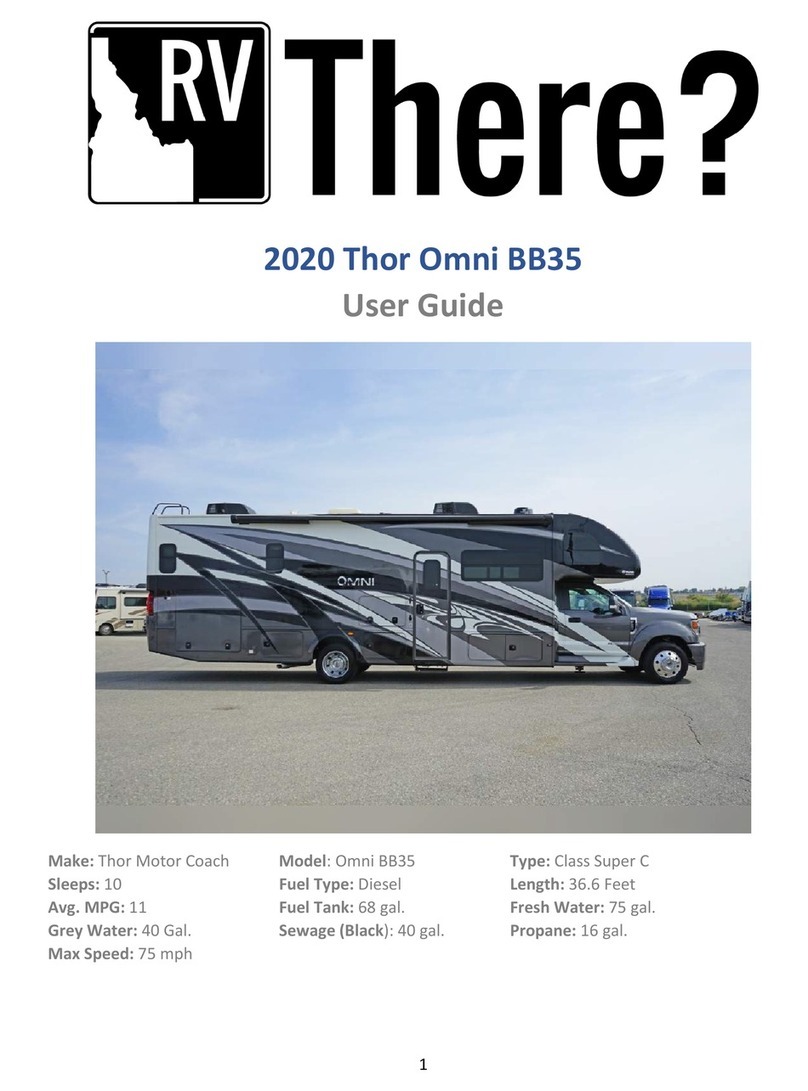
Thor Motor Coach
Thor Motor Coach Omni BB35 2020 user guide
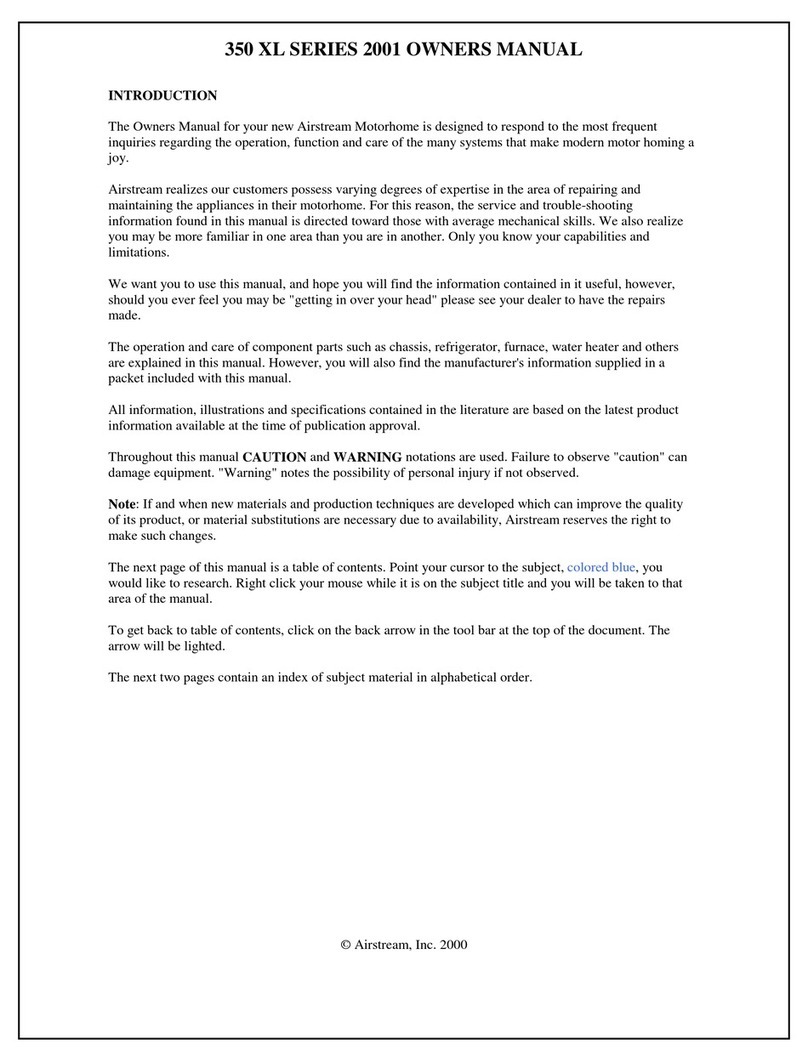
Airstream
Airstream 2001350 XL owner's manual


